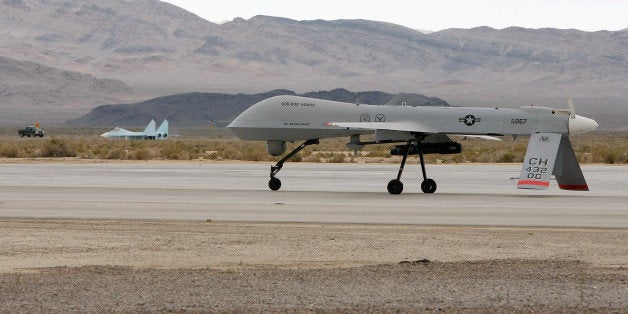
Before Nepal and Baltimore seized headlines, news that a CIA drone strike mistakenly killed an innocent American hostage in January momentarily energized our meager debate on drones. Critics pressed drones' dangerous secrecy and fallibility and the political backlash they produce in the Muslim world. The administration reached for platitudes about the sad inevitability of mistakes in the "fog of war."
Micah Zenko of the Council on Foreign Relations and author of a 2013 study of drones predicted, "even this episode will have no effect" on public debate -- and our easy distraction since Friday has proven him right.
Critics point to strong bipartisan support for drones as the reason for this inertia. But persistent questioning is all the more urgent because studies show that this apparent support arises out of a fundamental, deliberately propagated misunderstanding about how drones are used. According to a 2013 study, while most Americans approve drone strikes targeting high-level terrorist targets, they disapprove that recourse when there is the possibility of civilian deaths. In short, most Americans would disapprove the current use of drones if it were ever properly aired.
High-ranking military and diplomatic officials I have spoken to indicate that the problem is not military commitment to the drone strategy but our civilian leadership's commitment to it. Within the Air Force especially, skepticism about the tactic arises from the way CIA and the Joint Special Operations Command's independent, secret use of drones fatally compromises Air Force use of them.
I toured Creech Air Force Base in Nevada, where the USAF drones are remotely piloted. I was pressed afterwards not to disclose the circumstances of the tour. I do not have much faith in the reasoning behind keeping them secret, but some deluded sense of honor ties my tongue, redoubled by my sensitivity as a South-Asian-American to suspicions of my patriotism after I was warned that describing the circumstances would somehow endanger the security of our service men and women (although arguably disclosure in the name of democracy is patriotic duty, too).
Such are the liabilities of being a hyphenated American with ancestral ties to the geography being bombed. My son, whose name happens to have an Arabic root, was put on a Homeland Security no-fly list despite being self-evidently three years old. These are real-life worries, and so I compromise.
More significantly, that I did visit the base but was censored from writing about it suggests the military is playing a double-game, inviting public oversight on its own terms to safely air its doubts about the drone strategy while its siege mentality prevents a full and clear airing of them as part of real public debate.
While criticism remains episodic and marginal, the men and women who run operations at Creech are in thrall to Orientalist notions about the "culture" of people in the AfPak region. Thus, for example, some believe Afghani men are indifferent to the death of women and children without considering that Americans might appear similarly indifferent to Afghanis given our own evident tolerance of civilian deaths there.
Orientalist notions about the terrain's otherworldliness are also in play, situating it somewhere beyond the pale of civilization where al Qaeda finds sanctuary and thus where drone use can be countenanced in a way it would not be tolerated elsewhere. Indeed, romantic descriptions of a fantastically remote, thickly-forested valley surrounded by snow-capped peaks ran through the New York Times coverage of the American hostage's death in the Shawal Valley.
I have written extensively about how our military inherited these views from the British who first attempted to police the region from the air after World War I. They are crucial to drone operators' ability to press the trigger, keeping the region permanently unreal and alien, an eternal frontier-zone where civilization ends and something else, ungovernable, begins.
As much as defenders of drone strikes tout the hours of close surveillance that give remote pilots a kind of intimacy with their victims, in fact, one-way surveillance of that kind is not aimed at producing empathy but greater confidence in the target's presumptive otherness. Creech's motto is "Home of the Hunters," and the first hunter-killer drone is called the "Predator." Every good hunter must know its prey's habits well, but we would never mistake that intimate knowledge for empathy.
The ugly truth is that our official policy is to count all dead as militants -- that is how we dispensed with the matter of civilian casualties until last week's inconvenient news of the deaths of an American hostage and Italian aid worker.
The cause of this absurd policy is not lack of civilian oversight of the military but lack of democratic oversight of our civilian leadership. The day after the New York Times remarked the folly of drone tactics revealed by the death of an innocent American, the paper fawned over the program's decimation of al Qaeda leadership -- feebly in the end, for the article had to admit that al Qaeda has declined primarily because would-be militants prefer ISIS, hardly a development our drone strategists should be proud of.
It is time for us, as Americans, to exercise our responsibility as citizens and take control of the debate. Our leadership does not want journalists demanding revelatory tours of Creech. Journalists and citizens, demand a tour. At the very least, demand an account of and an apology for every civilian death. Drones routinely terrorize and kill civilians. Is this American culture?